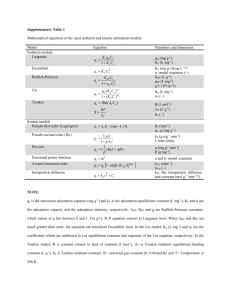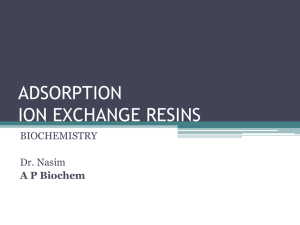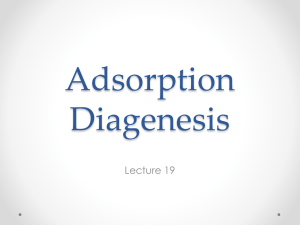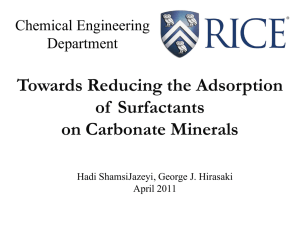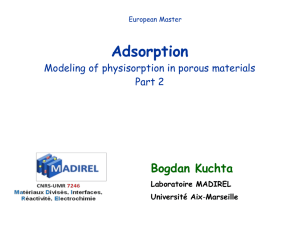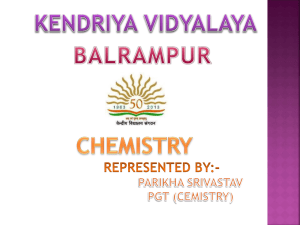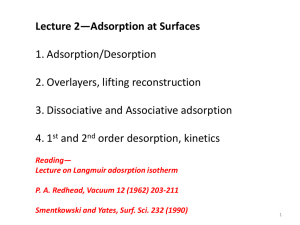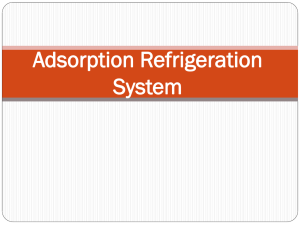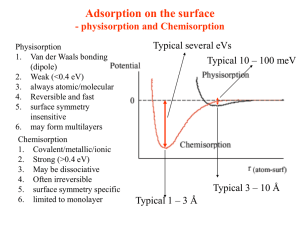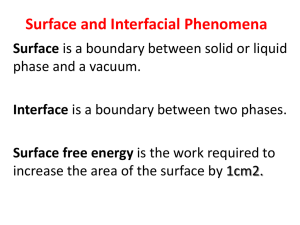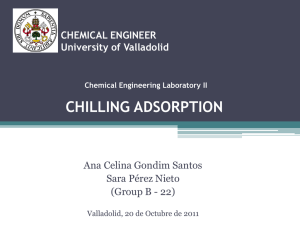mg g -1
advertisement
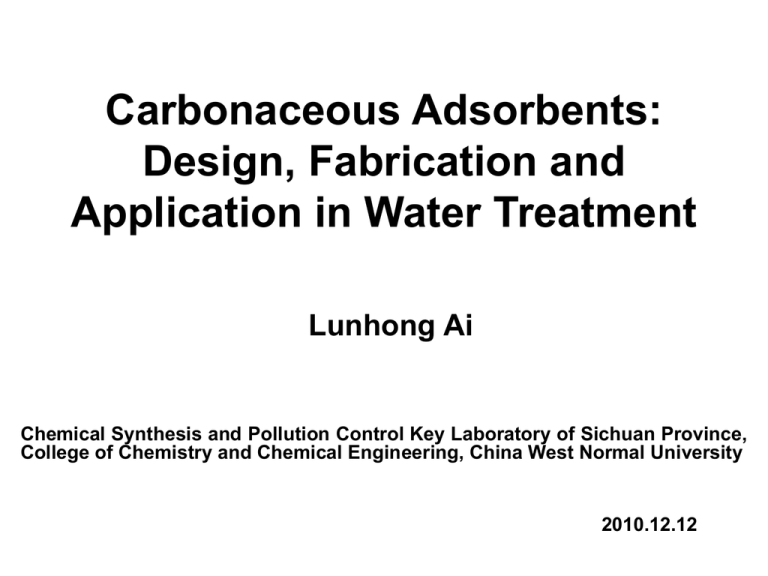
Carbonaceous Adsorbents: Design, Fabrication and Application in Water Treatment Lunhong Ai Chemical Synthesis and Pollution Control Key Laboratory of Sichuan Province, College of Chemistry and Chemical Engineering, China West Normal University 2010.12.12 Contaminated Rivers and Lakers Water treatment methods biological treatment ion exchange adsorption Water Treatment coagulation/flocculation membrane filtration advanced oxidation technology Available adsorbents Carbonaceous materials Nanomaterials Biomass Adsorbent Functional polymer Clay Zeolites Carbonaceous materials for water treatment Carbon activated carbon, carbon black carbon nanotubes graphene 1. Fabrication of activated carbon/CoFe2O4 composites and their application in water treatment XRD (c) TEM Intensity (a.u.) SEM AC/CFO CFO 20 30 40 50 60 2Theta (degree) magnetic separation (d) texture property Samples BET-surface area (m2 g-1) Total pore volume (cm3 g-1) AC 909 0.47 AC/CFO 463 0.18 L. Ai et al. / Chemical Engineering Journal 156 (2010) 243–249 70 Removal of malachite green (MG) 100 -1 Adsorption capacity (mg g ) Effect of pH -1 Adsorption capacity (mgg ) 50 49 48 47 2 4 6 8 75 50 25 Effect of initial concentration 0 10 0 pH 8 12 16 -1 Equilibrium concentration (mg L ) 40 regeneration -1 -1 Adsorption capacity (mg g ) 60 Adsorption capacity (mg g ) 4 45 Effect of contact time 30 15 0 30 20 10 0 0 5 10 15 20 Contact time (min) 25 30 1 2 Cycle number 3 2. Adsorption mechanism of methyl orange (MO) and basic fuchsin (BF) on AC/CFO L. Ai, et. al. / Desalination 262 (2010) 134–140 adsorption kinetics Adsorption kinetics pseudo-first-order model pseudo-second-order model Elovich model ※ adsorption kinetics was best described by the pseudo-second-order model adsorption kinetics Table 1 Kinetic parameters for adsorption of dyes on AC/CFO Pseudo-first-order Pseudo-second-order Elovich Dye qe,exp (mg g-1) k1 (min-1) qe,cal (mg g-1) R2 k2 (g mg-1 min-1) qe,cal (mg g-1) R2 a b R2 BF 49.88 0.067 6.83 0.9816 0.022 50.53 1 2.241 41.167 0.9624 MO 47.31 0.084 7.15 0.9372 0.026 47.94 0.9999 1.886 39.979 0.9531 adsorption mechanisms Adsorption mechanisms intraparticle diffusion intraparticle diffusion surface adsorption surface adsorption intraparticle diffusion model ※ the adsorption process was controlled by surface adsorption (boundary-layer effect) and intraparticle diffusion. adsorption mechanisms Boyd kinetic model was generally used to determine the actual rate-controlling step involved in the dye adsorption process. Boyd model ※ boundary-layer effect mainly governed the rate-limiting process of dye adsorption on AC/CFO adsorption isotherms Adsorption isotherms Langmuir and Freundlich models 90 BF 100 MO 75 80 qe (mg g ) 60 -1 -1 qe (mg g ) 60 40 Experimental Langmuir Freundlich 20 0 0 5 10 -1 Ce (mg L ) 45 30 Experimental Langmuir Freundlich 15 15 0 0 5 10 15 20 25 30 -1 Ce (mg L ) ※ Dye adsorption behaviors onto AC/CFO could be better represented by the Langmuir model (R2 > 0.99) ※ Monolayer adsorption capacities of MO and BF determined from the Langmuir isotherm are 95.8 and 101.0 mg g−1, respectively adsorption isotherms Dubinin-Radushkevich (D-R) model 4.6 MO BF 4.4 4.2 lnqe 4.0 3.8 3.6 3.4 3.2 500 600 700 800 2 900 1000 -2 (kJ mol ) For D-R model, the magnitude of E(mean fren energy) is useful for estimating the type of adsorption and if this value is between 8 and 16 kJ mol−1, the adsorption proceeds by surface adsorption. In this study, the E values for MO and BF are calculated to be 11.74 and 12.42 kJ mol−1. Table 3. Comparison of BF and MO adsorption capacities of various adsorbents Dye Adsorbents Adsorption capacity (mg g-1) BF AC/CFO (in this study) 101.01 Bottom ash 6.39 Deoiled soya 12.03 Jalshakti® 11.7 Industrial sludges 70.4 AC/CFO (in this study) 95.78 Hypercrosslinked polymeric adsorbent 70.922 Banana peels 21 Orange peels 20.5 Activated Carbon 9.49 Modified sporopollenin 5.23 NH3+-MCM-41 366.57 MO Acknowledgement Financial support from the Chemical Synthesis and Pollution Control Key Laboratory of Sichuan Province and Scientific Research Start-up Foundation of China West Normal University (07B005).

